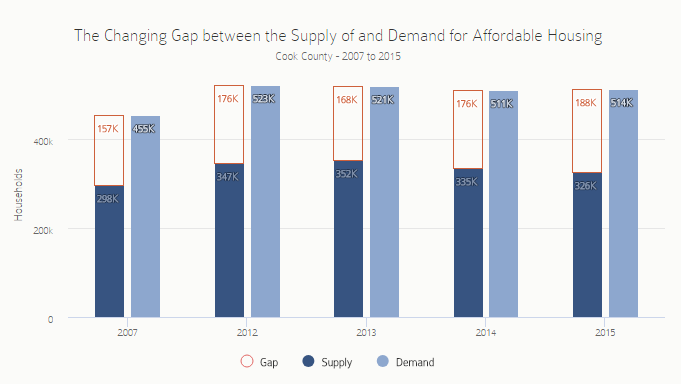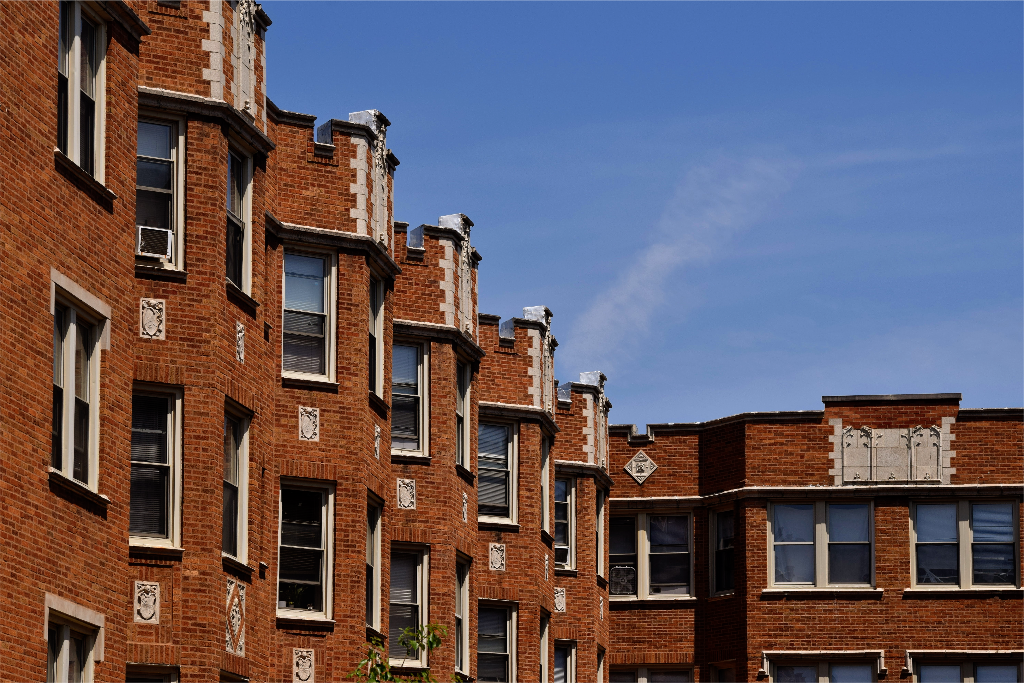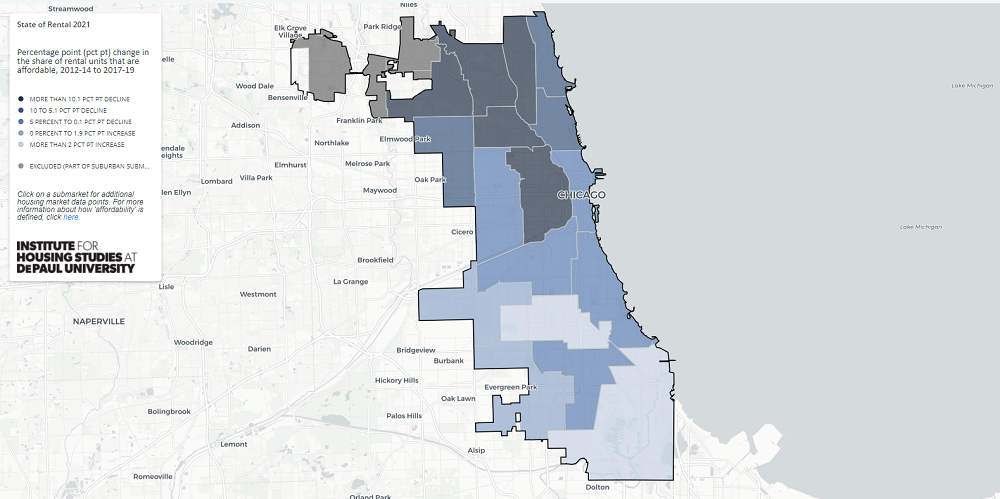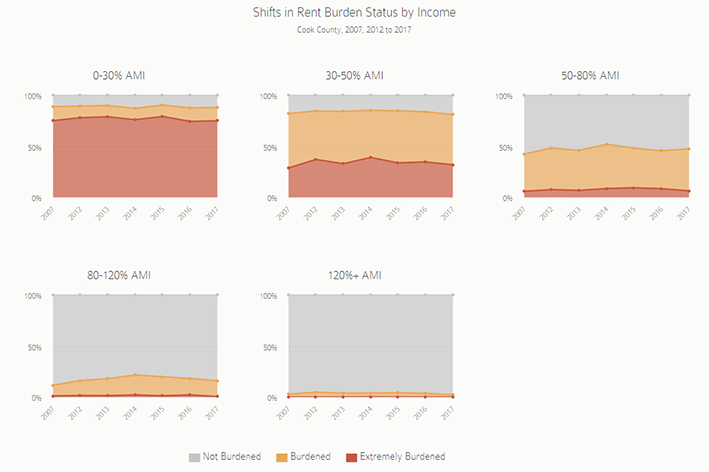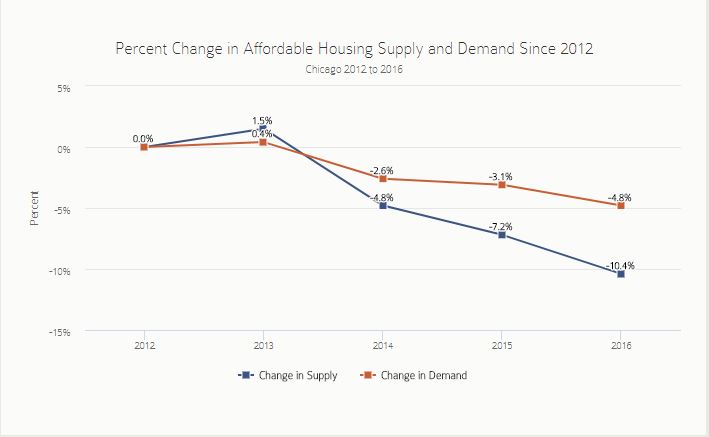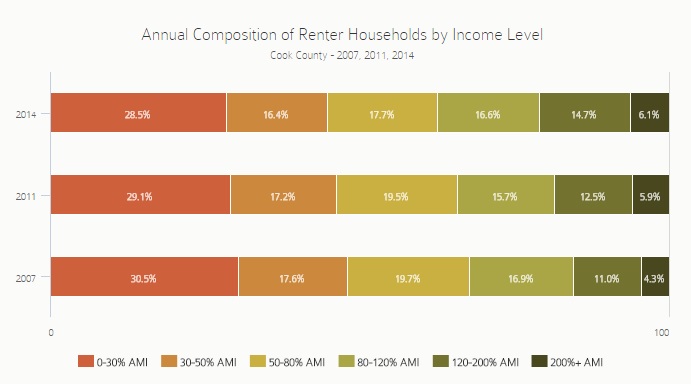The newest release of the State of Rental Housing in Cook County updates key data on changing rental demand, the supply of rental housing, and how these dynamics are affecting access to affordable rental housing for Cook County's lowest income households. The report focuses on conditions in 2015, the most recent data available from the American Community Survey, and compares data to trends reported in previous IHS reports. This report also includes data on affordable rental demand and rental market affordability for 34 submarkets in the City of Chicago and suburban Cook County.
For information on data sources and methodology, click here. To access the data behind the figures in the report, click here. For more on how these data connect to local and national housing and community development policy issues, see the affordability series on the IHS blog.
Key trends in rental demand:
Cook County's rental rate is at its highest level since 1990
Continuing its post-housing crash climb, Cook County’s rental rate is at a new peak. The charts below show the change in the share of Cook County households that were renters between 1990 and 2015 and the number of households that rented or owned during this same period. Multiple IHS reports have documented that, since 2007, the rental rate in Cook County has steadily increased as a result of declining demand for homeownership and a shifting preference for rental housing. In 2015, 44.2 percent of Cook County households were renters, an increase of roughly 17,900 renter households over 2014 and the highest rental rate since 2000. Conversely, the number of owner households declined slightly by roughly 1,200 households during this same period. The 2015 rental rate is just .3 percentage points below levels in 1990, a period just before national housing policy shifted towards heavily promoting homeownership.
;
The number of higher-income renters in Cook County continues to increase
The charts below examine the number of renter households in each income group pre-recession in 2007 and annually during the recovery period 2012-2015 as well as the composition of all renter households by income group during this same period. The recession led to an increase in renters across all income groups in Cook County, but in particular, there was an increase in lower-income renters between 2007 and 2012. As the economy improved after 2012, the number of very low-income renter households declined while there were increases in higher-income renter households. This has led to shifts in the composition of renter households by income level. In 2015, this trend is largely unchanged, with moderate increases in renters earning between 30 and 50 percent of the Area Median Income (AMI) as well as increases in renters earning more than 200 percent of AMI. The median household income in the Chicago Metropolitan Statistical Area in 2015 was $63,153.
Despite these shifts, very low-income households continue to represent the largest share of Cook County renter households (27.6 percent of renters), but households earning more than 120 percent of the AMI make up a growing share of the renter population now accounting for 21 percent of Cook County’s renter population. In 2015, renters earning less than 30 percent of AMI earned less than $18,946 while renters earning 120 percent or more of AMI earned at least $75,784.
;
Growth in young renters slows
The charts below show the number of renter households in each age group (determined by the age of the head of household) pre-recession in 2007, and annually during the recovery period 2012-2015 as well as the composition of renter households by age during this same period. Last year’s State of Rental Housing in Cook County report highlighted that, between 2007 and 2014, the overall increase in renter households was largely driven by younger renters. In 2015, the number of renters 25 to 34 remained relatively flat while there were increases for all other renter groups by age. In particular, there has been a steady increase in renters over 55 who now account for over 27 percent of Cook County’s renter population. As Cook County, and the nation, continues to get older, it raises key questions about how the housing market will respond to an aging population.
;
Key trends in rental supply:
Cook County’s stock of rental units in two to four unit buildings is declining
The chart below shows the composition of the rental stock by building size pre-recession in 2007, and annually during the housing market recovery period 2012-2015. Continuing a trend identified in last year’s State of Rental Housing in Cook County report, the share of rental units in single-family homes and larger multifamily buildings continues to increase, while the share of rental units in two-to-four unit buildings continues to shrink. Whereas annually, on average, units were added to the rental stock for every other type of building, Cook County lost an average 5,709 rental units annually in two to four unit buildings between 2012 and 2015. Over this period, the share of Cook County’s rental units in two to four unit buildings declined from 33.2 percent to 30.4 percent. Previous IHS reports have linked these declines to foreclosure-associated deterioration and vacancy, but also to the conversion of these small rental buildings to single family homes in strong markets.
Key trends in rental affordability:
As the economy improves, rental housing affordability is an increasing challenge
Continued annual increases in demand for affordable housing post-recession has led to a persistent and growing “affordability gap,” or the difference between the demand for affordable rental housing by lower-income households and the supply of units that would be affordable at 30 percent of their income.
The chart below examines levels of affordable rental demand and supply and highlights the pre-recession affordability gap in 2007, and annually during the housing market recovery period 2012-2015. It shows that the affordability gap in Cook County is increasing, and is at a new high. After slight declines in the gap in 2013 due to slight increases in the stock of affordable units, the affordability gap in Cook County has continued to climb reaching a new peak of 187,848 units in 2015. This growth is largely attributed to a decreasing stock of housing units affordable to lower-income people as the real estate market continues to mend. Between 2014 and 2015, nearly 9,000 fewer affordable units were available to lower-income renters, despite a growth of over 2,500 renter households needing affordable housing.
High numbers of low-income households are extremely rent-burdened
The persistence of the affordability gap has meant that many Cook County households remain rent burdened: countywide 53 percent of renter households paid 30 percent or more of their income towards housing in 2015. The chart below shows the rent burden status of Cook County households by income level pre-recession in 2007, and annually during the housing market recovery period in 2012-2015. During this period, levels of rent burdened households have consistently been highest for renters with the lower incomes: annually roughly 90 percent of very low-income renters and 85 percent of low-income renters pay more than 30 percent of their incomes towards rent. While the share of rent burdened households declined slightly in 2013, the share of rent burdened households again increased in 2014 and 2015.
Additionally, severe rent burden (the number of households paying 50 percent or more of their income towards rent) has continued to be an issue for low-income renter households during the recovery period. Last year’s State of Rental Housing in Cook County report noted the large increase in extreme rent burden for households earning at or below 50 percent of the area median after 2007. In 2015, these trends remain largely unchanged, with slight increases in shares of extremely rent burdened very low-income households, and slight declines in shares of extremely rent burdened low-income households.
The affordability gap continues to be highest in areas with high concentrations of low-income households
The interactive map below illustrates the variation in the gap between the demand for and supply of affordable rental housing for 34 submarkets in Cook County. Areas with large affordability gaps are those where substantial numbers of low-income households are rent burdened, paying more than 30 percent of their income towards rent.
The map shows that a cluster of south side Chicago neighborhoods that include Hyde Park, South Shore, Woodlawn, and Washington Park have the largest affordability gap in the County. This area has the largest number of affordable units in Cook County (over 32,000 units), as well as the highest demand for affordable rental housing from low-income households (roughly 46,500 renter households). Consistent with IHS’s 2016 State of Rental Housing in Cook County report, the west side submarket covering Humboldt Park, East/West Garfield Park, and North/South Lawndale and the north side submarket which includes Uptown and Rogers Park continue to have large affordability gaps. To access a full-screen version of the map, click here.
